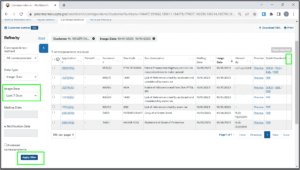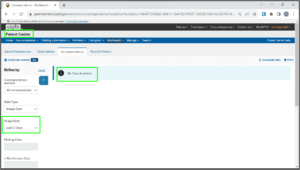
Patent Center bug CP151, which is one of the “high priority ticket” bugs, got quietly fixed by the USPTO within the past 36 hours. This would have been the ideal time for the USPTO to fix Patent Center bug CP31, which is also a “high priority ticket” bug and has been outstanding for more than three years now, but the USPTO failed to do that.
By way of background, one of the big problems with the USPTO’s management of the software development process for Patent Center is that when they fix one bug, it sometimes introduces a new bug. An example of this happened on September 18, 2023, when USPTO’s fixing of some other bug created new bug CP151. On that day, the ellipsis disappeared from the Outgoing Correspondence table, and as a consequence it became impossible to see the Attorney Docket Number when viewing outgoing correspondence from the USPTO.
Within the past 36 hours, the USPTO has restored the ellipsis to the Outgoing Correspondence table. You can see this in the screen shot above. This is, of course, good news for users of Patent Center. Users can once again make use of the Attorney Docket Number when viewing and downloading outgoing correspondence, just as they were able to do before September 18 (before the USPTO created this bug).
But the USPTO disappoints as well. The members of the Patentcenter Listserv have been asking nicely, again (December 16, 2021) and again (July 25, 2023) and again (September 29, 2023), for the USPTO to do the courtesy of letting the listserv know, by ticket number, when the USPTO thinks it has fixed a bug in Patent Center. And yet again this courtesy has not happened. The only way that we have learned of this bug fix is by stumbling upon it by accident.

The screen shot above highlights CP31, which has been outstanding for more than three years now. The screen shot above was taken on a Monday. On all Mondays and Tuesdays, a defect in Patent Center wrongly says that there is no outgoing correspondence even if there is outgoing correspondence. You can see this in the screen shot at right (Patent Center says “No Data Available”). In contrast, the exact same function in Private PAIR on a Monday or a Tuesday will list the actual outgoing correspondence.
This is because of a programming mistake in Patent Center. The correct number of days of look-back for outgoing correspondence is “seven” and this is the number of days that is PAIR uses. But the software coder for Patent Center made a mistake and used the number “three” for thenumber of days of look-back. This guarantees that on any Monday or Tuesday, Patent Center will incorrectly state that there is no outgoing correspondence at all, regardless of how much outgoing correspondence actually exists.
This is an example of the falsity of the USPTO’s claim that Patent Center provides “100%” of the functions of PAIR and EFS-Web. We reported this specific failure of the “100%” claim to Director Vidal on June 9, 2023.
I personally explained this defect in Patent Center (the incorrect use of the number “three” when it should be the number “seven” if it is to correctly match the function of PAIR) to the USPTO’s developers in a video conference on Wednesday, July 1, 2020, at about 2:15 PM Eastern Time. Even after the passage of more than three years, the USPTO has not corrected this simple coding error. This high priority ticket CP31 remains outstanding even now. And what is most disappointing is that the USPTO developers were working on this very section of the code (the outgoing correspondence table) within the past 36 hours when they were fixing bug CP151. They could have fixed this bug CP31 while they were at it.
The consequence of this coding mistake (wrongly putting the number “three” into the code instead of “seven”) is that every user of Patent Center who uses it on a Monday or a Tuesday must remember to manually scroll the screen sideways to view the “look-back” number, and must then manually change the “look-back” number from “three” to “seven”, followed by manually scrolling the screen downwards to view the “Apply Filter” button, and must then manually click the “Apply Filter” button. Then the user must manually scroll back to the part of the screen where the actual outgoing correspondence may be viewed.
Yes, each of the tens of thousands of users of Patent Center must carry out each of these at least five mouse clicks, every Monday and Tuesday of every week. Some fifty thousand mouse clicks need to happen every week, because some USPTO coder is too stubborn to correct one character in one line of code so that Patent Center will match PAIR in the number of days of look-back.
The consequence of this USPTO stubbornness is a trap for the unwary. The Patent Center user that mistakenly believes the (false) claim by the USPTO that Patent Center really does bring forward “100%” of the functions of PAIR and EFS-Web will mistakenly think that by clicking on “view outgoing correspondence” in Patent Center on a Monday or a Tuesday, one will actually see the outgoing correspondence, just as it works (correctly) in PAIR. If this click in Patent Center leads to a screen that says there is no outgoing correspondence (as in the screen shot immediately above), then the unwary user of Patent Center will mistakenly conclude that there is no outgoing correspondence. The unwary user of Patent Center might then fail to docket some due date, and then might have an application go abandoned.
I explained this in detail in a June 23, 2020 blog article, and as mentioned above, I personally explained this to the USPTO’s developers a few days later in a video conference on Wednesday, July 1, 2020, at about 2:15 PM Eastern Time. And still the USPTO people have not corrected their coding error in Patent Center.
